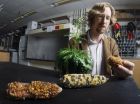(Press-News.org) In a finding that upends decades of scientific theory on reptile reproduction, researchers at North Carolina State University have discovered that female boa constrictors can squeeze out babies without mating.
More strikingly, the finding shows that the babies produced from this asexual reproduction have attributes previously believed to be impossible.
Large litters of all-female babies produced by the "super mom" boa constrictor show absolutely no male influence – no genetic fingerprint that a male was involved in the reproductive process. All the female babies also retained their mother's rare recessive color mutation.
This is the first time asexual reproduction, known in the scientific world as parthenogenesis, has been attributed to boa constrictors, says Dr. Warren Booth, an NC State postdoctoral researcher in entomology and the lead author of a paper describing the study. He adds that the results may force scientists to re-examine reptile reproduction, especially among more primitive snake species like boa constrictors.
The study is published online in Biology Letters, a Royal Society journal.
Snake sex chromosomes are a bit different from those in mammals – male snakes' cells have two Z chromosomes, while female snakes' cells have a Z and a W chromosome. Yet in the study, all the female babies produced by asexual reproduction had WW chromosomes, a phenomenon Booth says had not been seen before and was believed to be impossible. Only through complex manipulation in lab settings could such WW females be produced – and even then only in fish and amphibians, Booth says.
Adding to the oddity is the fact that within two years, the same boa mother produced not one, but two different snake broods of all-female, WW-chromosome babies that had the mother's rare color mutation. One brood contained 12 babies and the second contained 10 babies. And it wasn't because she lacked options: Male snakes were present and courted the female before she gave birth to the rare babies. And the versatile super-mom had previously had babies the "old-fashioned way" by mating with a male well before her two asexual reproduction experiences.
Booth doubts that the rare births were caused by environmental changes. He notes that while environmental stresses have been associated with asexual reproduction in some fish and other animals, no changes occurred in the mother boa's environment or routine.
It's possible that this one snake is some sort of genetic freak of nature, but Booth says that asexual reproduction in snakes could be more common than people think.
"Reproducing both ways could be an evolutionary 'get-out-of-jail-free card' for snakes," Booth says. "If suitable males are absent, why waste those expensive eggs when you have the potential to put out some half-clones of yourself? Then, when a suitable mate is available, revert back to sexual reproduction."
A reptile keeper and snake breeder, Booth now owns one of the young females from the study. When the all-female snake babies reach sexual maturity in a few years, Booth will be interested to see if they mate with a male, produce babies without a mate, or – like their mother – do both. In any case, these WW-chromosomed females will continue their version of "girl power," as any baby they produce will also be female.
INFORMATION:
Drs. Coby Schal and Ed Vargo co-authored the paper. Co-author Sharon Moore raised the snakes in the study. Co-author and veterinarian Daniel Johnson provided surgical sex testing on the snakes. NC State's Department of Entomology is part of the university's College of Agriculture and Life Sciences.
"Evidence for viable, non-clonal but fatherless Boa constrictors"
Authors: Warren Booth, Coby Schal and Edward L. Vargo, North Carolina State University; Daniel H. Johnson, Avian and Exotic Animal Care; Sharon Moore, The Boastore
Published: Online Nov. 3, 2010, in Biololgy Letters
Abstract: Parthenogenesis in vertebrates is considered an evolutionary novelty. In snakes, all of which exhibit genetic sex determination with ZZ:ZW sex chromosomes, this rare form of asexual reproduction has failed to yield viable female WW offspring. Only through complex experimental manipulations have WW females been produced, and only in fish and amphibians. Through microsatellite DNA fingerprinting, we provide the first evidence of facultative parthenogenesis in a Boa constrictor, identifying multiple, viable, non-experimentally induced females for the first time in any vertebrate lineage. Although the elevated homozygosity of the offspring in relation to the mother suggests that the mechanism responsible may be terminal fusion automixis, no males were produced, potentially indicating maternal sex chromosome hemizygosity (WO). These findings provide the first evidence of parthenogenesis in the family Boidae (Boas), and suggest that WW females may be more common within basal reptilian lineages than previously assumed.
Main squeeze not needed for boa mom
Boa constrictor has babies without mate; produces babies with characteristics deemed impossible
2010-11-04
ELSE PRESS RELEASES FROM THIS DATE:
UGA study finds moving animals not a panacea for habitat loss
2010-11-04
Athens, Ga. – New University of Georgia research suggests moving threatened animals to protected habitats may not always be an effective conservation technique if the breeding patterns of the species are influenced by a social hierarchy.
Research, published in the early online edition of the journal Biological Conservation, found an initial group of gopher tortoises released on St. Catherine's Island, Ga. were three times more likely to produce offspring than a later-introduced group, although the initial group had a much smaller proportion of reproduction-aged males.
"There ...
Most river flows across the US are altered by land and water management
2010-11-04
The amount of water flowing in streams and rivers has been significantly altered in nearly 90 percent of waters that were assessed in a new nationwide USGS study. Flow alterations are a primary contributor to degraded river ecosystems and loss of native species.
"This USGS assessment provides the most geographically extensive analysis to date of stream flow alteration," said Bill Werkheiser, USGS Associate Director for Water. "Findings show the pervasiveness of stream flow alteration resulting from land and water management, the significant impact of altered stream ...
The developmental dynamics of the maize leaf transcriptome
2010-11-04
Photosynthesis is arguably the most impressive feat of nature, where plants harvest light energy and convert it into the building blocks of life at fantastically high efficiency. Indeed modern civilization became possible only with the cultivation of plants for food, shelter and clothing.
While scientists have been able to discover details of the fascinating process by which plants store solar energy as chemical energy, how developing plants build and regulate their solar reactors is still poorly understood. How many genes are involved, and which are the most important? ...
Tropical Storm Anggrek is tightly wrapped in NASA satellite imagery
2010-11-04
Bands of strong thunderstorms are wrapping around the center of Tropical Storm Anggrek in the Southern Indian Ocean, according to satellite imagery. NASA's Aqua satellite captured an infrared look at those strong thunderstorms today.
NASA's Aqua satellite passed over Anggrek on Nov. 3 at 07:05 UTC (3:05 a.m. EDT) and the Atmospheric Infrared Sounder (AIRS) instrument onboard captured an infrared image of the cold thunderstorms within the system. The image showed that strong, high thunderstorm cloud tops tightly circled the storm's center. There was also strong convection ...
NASA satellite sees Tomas weaken to a tropical depression ... for now
2010-11-04
NASA infrared satellite data from this morning revealed that Tropical Storm Tomas has weakened into a tropical depression.
Tomas is in the central Caribbean Sea headed for Haiti this weekend, and forecasters are calling for a re-intensification before it makes landfall.
The National Hurricane Center (NHC) in Miami, Fla. reported at 5 a.m. EDT on Nov. 3 that hurricane hunter aircraft found an "ill-defined and elongated circulation with no tropical storm-force winds at the flight level or the surface." Thus, the status of Tomas was changed from a tropical storm to a ...
Volcanoes have shifted Asian rainfall
2010-11-04
Scientists have long known that large volcanic explosions can affect the weather by spewing particles that block solar energy and cool the air. Some suspect that extended "volcanic winters" from gigantic blowups helped kill off dinosaurs and Neanderthals. In the summer following Indonesia's 1815 Tambora eruption, frost wrecked crops as far off as New England, and the 1991 blowout of the Philippines' Mount Pinatubo lowered average global temperatures by 0.7 degrees F—enough to mask the effects of manmade greenhouse gases for a year or so.
Now, scientists have shown ...
Headgear, mouth guards have little or no impact on reducing concussions in rugby players
2010-11-04
TORONTO, Ont., Nov. 3, 2010 – Existing headgear and mouth guards have limited or no benefit in reducing concussions in rugby players, according to Dr. Michael Cusimano, a neurosurgeon at St. Michael's Hospital.
However, educational injury prevention programs that promote proper playing techniques and enforcement of the rules do result in a significant reduction in concussions and head, neck and spinal injuries, Cusimano concluded after a review of existing studies on the topic.
Cusimano still recommends rugby players wear mouth guards and protective headgear ...
Chromosome imbalances lead to predictable plant defects
2010-11-04
WEST LAFAYETTE, Ind. - Physical defects in plants can be predicted based on chromosome imbalances, a finding that may shed light on how the addition or deletion of genes and the organization of the genome affects organisms, according to a study involving a Purdue University researcher.
The findings identify easily measured characteristics that vary with imbalances of specific chromosomes, said Brian Dilkes, a Purdue assistant professor of horticulture. Understanding why and how those imbalances result in certain characteristics could open the door to correcting those ...
E. coli thrives near plant roots, can contaminate young produce crops
2010-11-04
WEST LAFAYETTE, Ind. - E. coli can live for weeks around the roots of produce plants and transfer to the edible portions, but the threat can be minimized if growers don't harvest too soon, a Purdue University study shows.
Purdue scientists added E. coli to soil through manure application and water treated with manure and showed that the bacteria can survive and are active in the rhizosphere, or the area around the plant roots, of lettuce and radishes. E. coli eventually gets onto the aboveground surfaces of the plants, where it can live for several weeks. Activity in ...
U of M researcher finds public support for HPV vaccine wanes when linked to controversy
2010-11-04
MINNEAPOLIS / ST. PAUL, Minn. (Nov. 2, 2010) – The vaccine that protects against the potentially cancer-causing human papillomavirus (HPV) enjoys wide support in the medical and public health communities. Yet state laws to require young girls to be vaccinated as a requirement for middle school attendance have aroused controversy with parents, politicians, and even medical and public health experts disagreeing about whether such laws are appropriate. News coverage about HPV vaccine requirements tends to amplify this controversy, possibly leading to negative attitudes among ...
LAST 30 PRESS RELEASES:
Emergency departments fall short on delivering timely treatment for sickle cell pain
Study shows no clear evidence of harm from hydroxyurea use during pregnancy
Long-term outlook is positive for most after hematopoietic cell transplant for sickle cell disease
Study offers real-world data on commercial implementation of gene therapies for sickle cell disease and beta thalassemia
Early results suggest exa-cel gene therapy works well in children
NTIDE: Disability employment holds steady after data hiatus
Social lives of viruses affect antiviral resistance
Dose of psilocybin, dash of rabies point to treatment for depression
Helping health care providers navigate social, political, and legal barriers to patient care
Barrow Neurological Institute, University of Calgary study urges “major change” to migraine treatment in Emergency Departments
Using smartphones to improve disaster search and rescue
Robust new photocatalyst paves the way for cleaner hydrogen peroxide production and greener chemical manufacturing
Ultrafast material captures toxic PFAS at record speed and capacity
Plant phenolic acids supercharge old antibiotics against multidrug resistant E. coli
UNC-Chapel Hill study shows AI can dramatically speed up digitizing natural history collections
OYE Therapeutics closes $5M convertible note round, advancing toward clinical development
Membrane ‘neighborhood’ helps transporter protein regulate cell signaling
Naval aviator turned NPS doctoral student earns national recognition for applied quantum research
Astronomers watch stars explode in real time through new images
Carbon-negative building material developed at Worcester Polytechnic Institute published in matter
Free radicals caught in the act with slow spectroscopy
New research highlights Syntax Bio’s platform for simple yet powerful programming of human stem cells
Researchers from the HSE University investigated reading in adolescents
Penn Nursing study: Virtual nursing programs in hospitals fall short of expectations
Although public overwhelmingly supports hepatitis B vaccine for a newborn, partisan differences exist
DFW backs UTA research to bolster flood resilience
AI brain scan model identifies stroke, brain tumors and aneurysms – helping radiologists triage and speed up diagnoses
U.S. News & World Report gives Hebrew Rehabilitation Center highest rating
Optica and DPG name Antoine Browaeys 2026 Herbert Walther Award recipient
The presence of a gun in the home increases the risk of suicide by three to five times
[Press-News.org] Main squeeze not needed for boa momBoa constrictor has babies without mate; produces babies with characteristics deemed impossible






